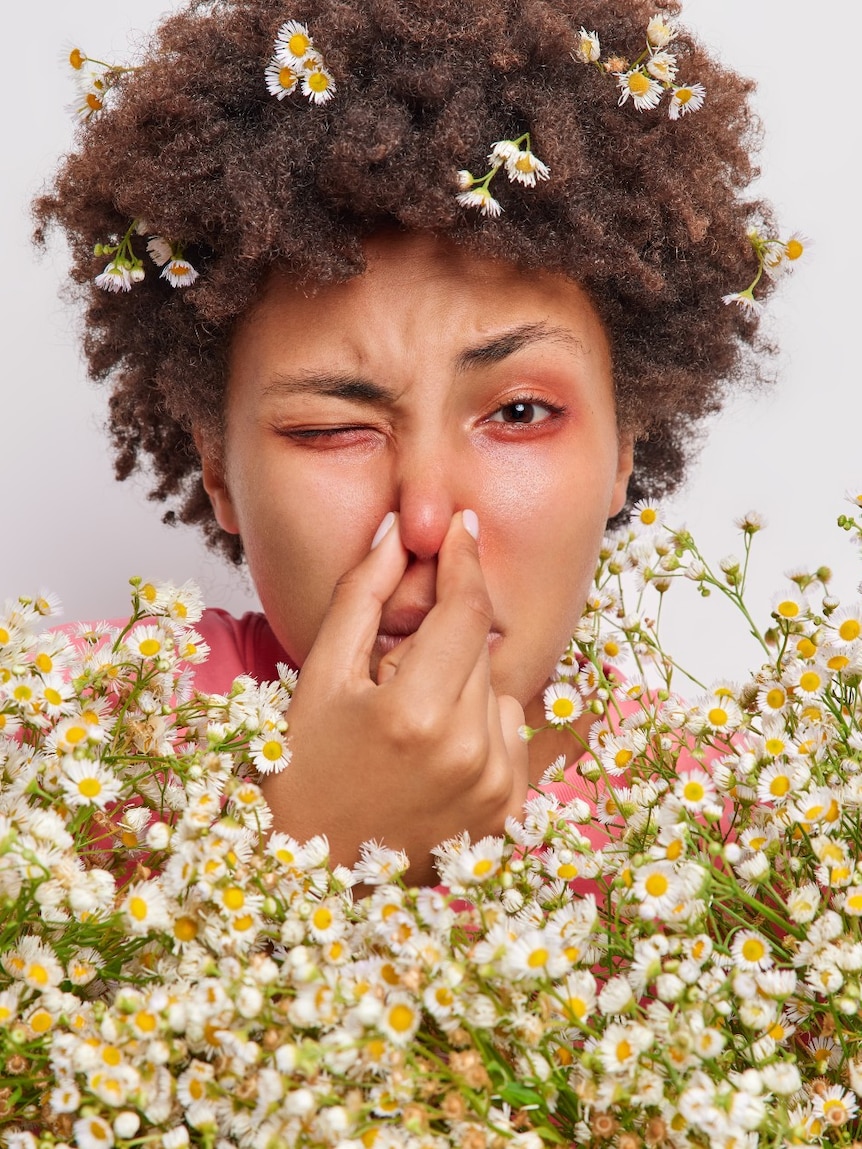For me, the first sign is usually itchy eyes on my ride into work.
If I don’t get an antihistamine into me quick- smart, I’m in for the inevitable descent into sniffles and sneezes as the morning wears on.
It’s a common story. I’m one of the 4.6 million Australians who get allergic rhinitis — better known as hay fever.
Every year, like clockwork, I inhale pollen floating in the sweet springtime air as I fang through the CBD on my bike.
And, like clockwork, my immune system detects pollen allergens — proteins on and inside the pollen grain — and springs into action, trying to force the pollen out while triggering inflammation, which I register as incessant sneezing and puffy eyes.
Pollen’s not the only culprit behind seasonal hay fever: fungal spores can trigger allergic rhinitis too, and irritants — such as the microscopic hairs dropped by plane trees — may not cause an immune reaction, but can make you cough and splutter if you inhale them.
This yearly immune system overreaction isn’t much of a bother for me. It’s nothing over-the-counter tablets can’t quell, and it usually only lasts a few weeks.
But for people with allergic asthma, pollen season is potentially danger season, more so if thunderstorms are on the horizon — not to mention climate change.
The problem with pollen
The pollen that causes my annual allergy anguish comes from plants that rely on wind to disperse their pollen — mostly grasses, says Kira Hughes, a PhD candidate at pollen counting and forecasting facility Deakin Airwatch.
Some trees are involved too — but not the ones you might expect.
“Many people think their hay fever is triggered by wattle, especially because its pollen is vibrant and gets everywhere,” Ms Hughes says.
“But wattles are usually pollinated by insects, so the pollen grains are heavy and can’t be carried far by the wind.”
It might not even be the grasses growing around your house, or even in your town or city, making you sneeze.
“Grass pollen can travel hundreds of kilometres at speeds up to 15 kilometres an hour,” Ms Hughes says.
For instance, Melbourne, which is staring down the barrel of a particularly bad hay fever season, is awash in pollen that blows in from farmlands well north of the city.
And the pollen problem intensifies if you throw a thunderstorm into the mix, as the city found out in 2016.
Whole pollen grains are generally too big to travel further than our upper airway — that’s our nose, mouth and throat.
But they’re full of tiny starch particles, sometimes hundreds of them — a bit like a beanbag filled with beans, Ms Hughes says.
In the right conditions — like the hot humidity of a thunderstorm — the pollen grain beanbag can rupture and spill its starchy “beans”.
“All of those little ‘beans’ are covered with allergens, and because they’re so tiny, they can get into your lower lungs and cause those really severe asthmatic symptoms.”
Why all the pollen in dry, sunny weather?
There’s a good reason hay fever season tends to kick off in Melbourne when the clouds part and the sun finally starts to shine.
For wind-pollinating plants, who want to spread their pollen far and wide, there’s no point in releasing their precious cargo when it’s raining, as it’ll simply be washed onto the ground.
So they hang onto it until the weather clears.
For this reason, the first dry day after a long spell of wet weather — like the conditions brought by La Niña — can be particularly bad pollen-wise, Ms Hughes says.
We saw this happen on Halloween. For most of October, Victoria’s wet weather kept pollen levels low.
But the skies cleared on October 31. It was the warmest, windiest day of the month for Melbourne, and pollen levels jumped to high or extreme across the state.
All the new grass growth has Ms Hughes worried that this pollen season could drag out longer than normal in Melbourne.
“With all this rain we’ve had, there’s so much grass, and we potentially could be getting high pollen numbers into December or even January.”
Right now, pollen air levels are monitored using pollen traps.
They suck air into a chamber and whatever’s in that air is stuck to a glass slide, which is removed and the pollen counted.
“The issue with those is they can take a long time to collect samples — about 24 hours at a minimum,” Ms Hughes says.
“So when we report our pollen counts online to the public, it’s always a day behind.”
What would help scientists track pollen trends, and people like me to better manage pollen exposure, is a network of automated devices, says Paul Beggs, an environmental health scientist at Macquarie University.
They’re expensive, but use lasers to analyse the contents of air as it’s sucked through a device, and can report pollen levels in real time.
“If we had more science and longer records, the forecasting would be better as well, as we’d have more data to base it on,” Dr Beggs says.
You think it’s bad now …
Pollen season severity and duration fluctuate year to year, but there’s a long-term trend that spells bad news for those who deal with hay fever and asthma.
That’s right: climate change is affecting when plants release their pollen.
We know this from observations in the real world, mostly Europe and the US (although Australian research is currently underway), as well as experiments in greenhouses, where temperature and carbon dioxide levels can be adjusted to see how they change how a plant pollinates.
Those greenhouse studies usually match up pretty well with observations, Dr Beggs says.
Some plants use temperature as their cue to start making pollen. When it gets warm enough, they start pumping it out.
As temperatures creep up, some plants start making pollen earlier, or keep producing it later than they normally would.
“Not every species, not every location, but for many species and many locations, there are changes in the timing of the pollen season,” Dr Beggs says.
“So if it’s a longer pollen season, then you’ll have symptoms over a longer period.”
Where plants grow as temperatures rise will change too.
Those that thrive in warmer areas will be able to spread from the tropics towards the poles, or up to higher elevations, potentially exposing people to new pollens — and new allergens.
Plus even relatively low increases in carbon dioxide can nudge pollen production up too.
Plants use carbon dioxide as part of photosynthesis to make sugar, which they can use as energy.
“In some ways, we’re fertilising plants by putting more CO2 into the atmosphere, so many plants are responding to those changes in the environment around them and producing more pollen,” Dr Beggs says.
Greenhouse studies even show that higher levels of CO2 can increase some species’ pollen’s “allergenicity” — in other words, it becomes nastier for those of us with hay fever and asthma.
For instance, ragweed is a major cause of seasonal hay fever in the US and Europe, and grows as a weed in south-east Queensland and northern NSW.
One study grew ragweed in CO2 concentrations projected for the middle of this century, and found those plants made pollen that contained more allergen than ragweed grown in today’s conditions.
“So in terms of a person’s exposure, they might be exposed to an allergen earlier than they used to be, and might be getting more of the allergens that they used to get,” Dr Beggs says.
“There might be more potent allergens around that they’re not used to being exposed to, and this might be the case for multiple pollen types — not just grass, but tree pollen as well.”
Space to play or pause, M to mute, left and right arrows to seek, up and down arrows for volume.




